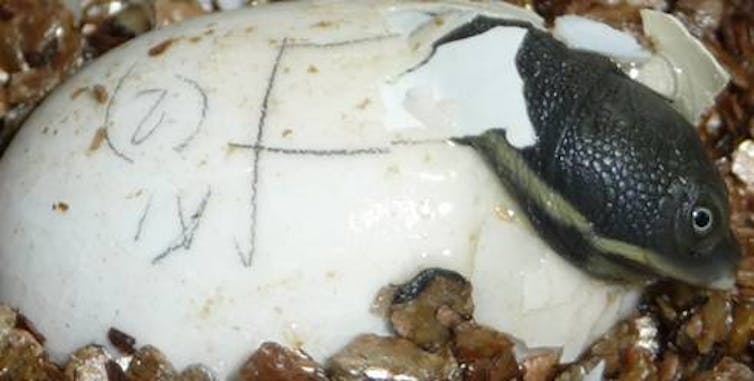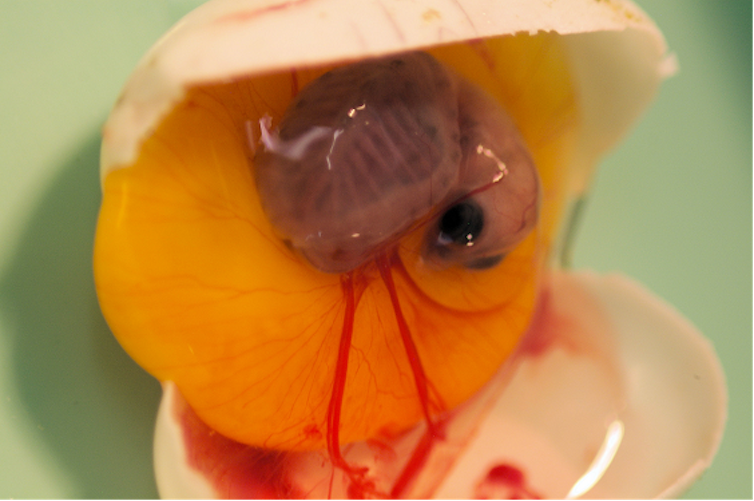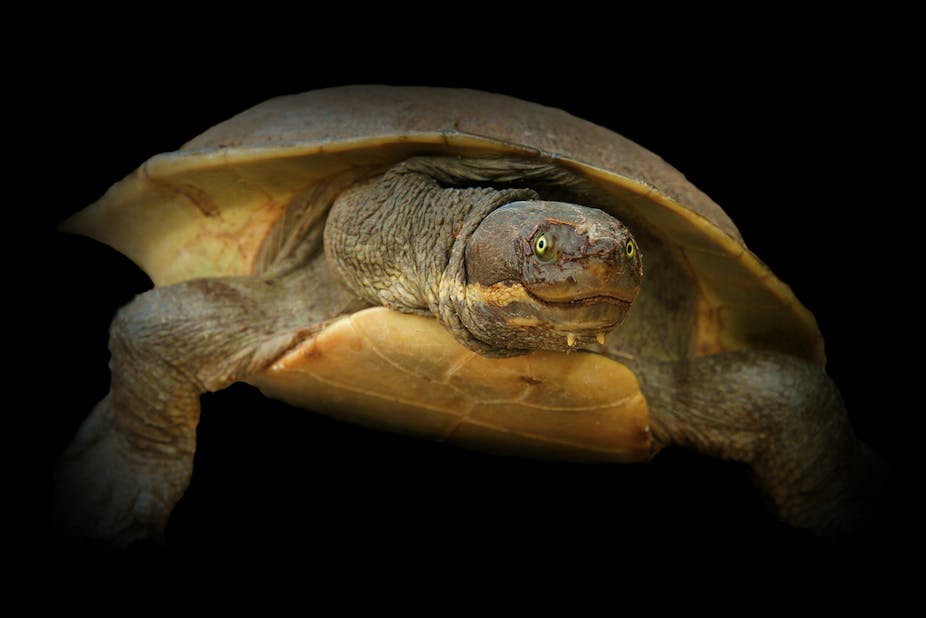Australian freshwater turtle embryos can sense how developed other babies are in their eggs and then speed up their own growth to hatch with the most advanced of their siblings, according to new research.
This inter-egg awareness and subsequent metabolic acceleration means that freshwater turtles (Emydura macquarii) that would otherwise hatch when the nest has been largely abandoned, and would therefore be easy prey, instead enter the world in the relative safety of a peer group.
The paper, “Embryonic communication in the nest: metabolic responses of reptilian embryos to developmental rates of siblings”, was written by a trio of University of Western Sydney scientists and is published today in Proceedings of the Royal Society B.
Co-author Dr Ricky Spencer said that the research team had known from previous research that some eggs were hatching before full term. “But we didn’t know how they did it; did they simply hatch early and prematurely, or were they able to somehow compensate and increase their developmental rate in response to the other members of their clutch?” Dr Spencer said.

Freshwater turtles use shallow nests to lay several layers of eggs. The eggs near the top of the nest enjoy temperatures up to 6 degrees Celcius higher than deeper laid eggs, “which results in shortened incubation periods relative to eggs near the bottom … thus hatching synchrony should not occur within a freshwater turtle nest because incubation times should differ significantly between eggs in different positions of the nest,” the report says. Yet, freshwater turtle embryos sitting low and cool in the clutch have a “catch-up mechanism”.
Dr Spencer said that this mechanism has a clear survival purpose. “These guys nest in such high density that there are probably a lot of other turtle nests [nearby] from which turtles are coming out, and if other turtles are coming out you’re going to get predators to the area. If you wait in the nest you’re a sitting duck,” Dr Spencer said. To keep with the group as it leaves the nest, he said, the turtles “hatch early and go almost straight away … they are communal nesters and they may have evolved to hatch and go as soon as possible.”
If the early hatching turtles were less developed than those from eggs at the nest’s warm upper layers, then they would be weaker and slower and more likely to be taken by predators, and while Dr Spencer said the team found “no real difference between their growth rates and those who were hatching normally.” Indeed, the study reports that “early hatching did not appear to reduce neuromuscular ability at hatching.” This was in contrast to other animals that can hatch early in order to emerge as a group. The report cites early-hatching Japanese quail chicks that take up to two hours longer to be able to stand than their normal peers, and painted turtles (C. picta), in which neromuscular function can be impaired for up to nine months after hatching.
Freshwater turtle embryos appear to be able to successfully accelerate their development by consuming more of the nutrients at hand than do their warmer siblings. “If you think about an egg with a chicken in it, you’ve got the yolk which feeds the chicken. It’s the same thing with turtles; they’ve got a big yolk sac and when they hatch out they’ve still got a lot of yolk left and they don’t have to feed for several weeks. But the ones that go through increased development have smaller yolk sacs [left after hatching],” Dr Spencer said.

How the cooler embryos know to speed up their metabolic rate is not known, but the research team has a couple of hypotheses. “There are probably cues like heart rate: so if you’ve got more advanced embryos in there then they have stronger heart rates. All the eggs are on top of each other in the nest so you’ll get vibrations,” Dr Spencer said.
Another cue might come from the gases emitted from the embryos. “Eggs breathe; they draw in oxygen and they breathe out carbon dioxide. If you’re in a nest and you’re completely within a closed chamber there might be large volumes of carbon dioxide in there which might give a cue; when you have some with a greater metabolic rate the slight difference in gas exchange might cue those that are less advanced to go, ‘Hang on, those guys are potentially more advanced than I am; I need to somehow increase my developmental rate, ” said Dr Spencer, who added that the pace is always set by the fastest developing siblings.
The Principal Investigator at the University of NSW’s Evolutionary Biology Lab, Russell Bonduriansky, raised the possibility that the rate of development was not improvised according to placement in the clutch, but is rather a normal function of gender. Embryonic sex determination is temperature-related in some turtles, Dr Bonduriansky said.
However, Dr Spencer said that this was not the case, as the sex of Emydura macquarii embryos is genetically determined with a 50-50 spread of boys and girls throughout the clutch.

